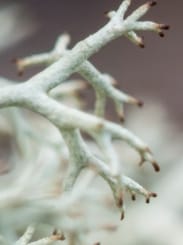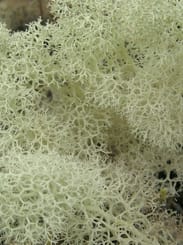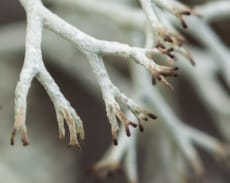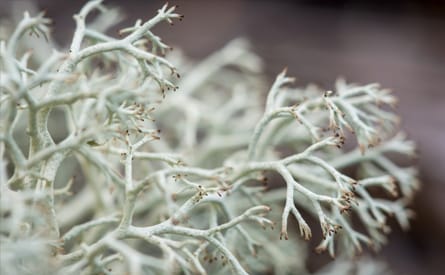

Reindeer Moss (Cladonia Rangiferina)
Proving date: 2000
Proving completed by: Misha Norland & The School of Homeopathy
Common name : Reindeer Moss
Download: Full proving Reindeer Moss (Cladonia Rangiferina)
Download: Proving rubrics
About Reindeer Moss
Dry, wet, slow, and symbiotic dependency.
In situations, perhaps due to perceptions of limited resources, life has become a dreary, disorganised drudge. There is a sense of tedium, a slowness of pace, a chronicity of symptom development. The patient may feel small, as if invisible, insignificant, their efforts are disorganised, they may feel duped, lied to, and taken for granted. They develop strong attachments to property, and money issues abound. They crave a soul mate, they easily feel jealous, and hard done by. They can feel that their partner belongs to them absolutely and that any separation, even for a moment, is unacceptable, and they can experience irrational suspicion and jealousy. They can feel forthright and confrontational, even angered to violence. When things are going well for this patient, they are calm, contented and there may be a nurturing earthiness about them. There are a preponderance of throat and respiratory symptoms typified by dryness. Also dryness of eyes, lips, mouth, cough, nails, and skin around the nose. Lack of the Water element, lack of trust in softer feelings of acceptance, of knowing it will be okay without having to fight for it, typify this patient for whom life is perceived as an uphill struggle.
Reindeer moss
Reindeer moss is a lichen (not a moss, as the name implies), an organism consisting of a fungus and unicellular algae in symbiosis. It is commonly found in the Arctic. The tubes and outer structure of the fungus provide shelter – a protected environment for the algae that photosynthesise and produce the sugars that feed them both. As in any symbiotic relationship, the cooperative function of each is necessary for the survival of the whole. The structure of Reindeer moss resembles bronchioles and, like other lichen remedies, has many pulmonary symptoms including wet coryza or a dry cough. The lichen can withstand very low temperatures and dry out, becoming dormant in these conditions. The moss bakes during long Summer days when it is exposed on rocks. It desiccates and can then be crumbled between the fingers, disintegrating into a grey-green powder. In the manner of a bath sponge, the moss becomes pliant when rehydrated. These lichens prefer acid soils as low as pH 4.5. If there is sufficient light the lichen is able to grow even when the temperature reaches as low as -10° C.
The lichen is made up of a thallus, or main body, with podetia growing from it. The plant is incredibly long-lived. The first stage of a podetium's development can last 25 years. It then enters a stable period in which new growth at the tip, is equal to die-off at the base; this portion of time can last 100 years. Then comes a phase of degeneration in which die-back exceeds growth. This stage too, can last 100 years. Regions even lightly grazed by caribou, can take several years to recover, and areas destroyed by fire or severely overgrazed can take a century to become lush again. Propagation of the plant relies mostly upon the spreading of thallus fragments by animals or being carried on the wind, but spores are also wind dispersed and transported over longer distances.
Caribou feed extensively on the moss during the Winter when very little other food is available. Reindeer moss is high in carbohydrates (up to 94%), which reindeer need to provide enough energy to keep warm. Reindeer can smell the moss through the snow and paw at the snow to get at it. It has been observed that during severe Winters, the otherwise peaceful caribou may fight over this valuable food source. Just as the reindeer are dependant on the moss, so in turn the Laplanders and the Inuit are dependent upon the reindeer. In the extreme Arctic conditions such relationships are absolute and any failing in them would undoubtedly result in extinction.
Mythology
Menomini legend: According to Menomini legend, lichens are said to be the scabs from the head of Ma’napus. He placed the scabs where they were to keep his uncles and aunts from starving. In addition, another version of this legend was that the lichens were the scabs from Ma’napus buttocks where he had been burnt, and as he slid down a slanting rock, they came off.
Okanagan-Colville legend: tells the story of the related lichen, Bryoria fremontii, being created from the hair of coyotes. The legend chronicles the tale of a coyote trying to catch some swans that end up sweeping him into the sky, and flying away with him. They let him go when he was high up in the air, and as he fell he was caught on the branches of some trees. Once he was able to free himself from the leaves, much of his hair was entangled in the branches. The coyote transformed this hair into Bryoria fremontii and said, ‘You, my hair, will not be wasted. The coming people will gather you and make you into food.’
History
Indigenous people of the Arctic: also known as Dene, ate reindeer moss by killing the reindeer and harvesting its stomach after the animal had consumed the lichen. They would remove the animal's stomach, adding the animal's blood. The mixture would ferment for a few days before being cooked and eaten. The acids in the lichen are still used to tan reindeer hides.
Alcohol: In the 1800s, Sweden led the World in lichen alcohol production, as an alternative to grain alcohol. Lichen brandy was popular and also used in the making of Akvavit. In Russia, a black treacle was made from the plant.
Food: Lichens are mostly carbohydrate. The acid content of the plant can bring about severe stomach cramps if consumed in any quantity. In China and Scandinavia, the plant is made edible by boiling it for 30 minutes, then soaking the lichen for 2 days in several changes of water, to which bicarbonate of soda can be added. The taste is much like mushrooms, and when cooked, can be left plain, mixed with other foods, or dried and added to flour to thicken soups and desserts.
Medicinal uses: Lichen is rich in vitamins A and B. Native Americans make a tea from the lichen, and use it to treat diarrhoea. It is also used as a laxative, a cough suppressant, to assist blood formation and to treat loss of appetite, gastritis, inflammation of the mouth, the pharynx and the intestines.
The proving
Reindeer moss has a capacity to survive the extremes of Arctic Winter, and desiccation by Summer conditions. We were drawn to prove the lichen due to its capacity to thrive under such extreme fluctuating conditions.
The dependency of caribou upon the organism, being a sole Winter food source, created a distinctive picture of endurance and possessiveness that emerged in the proving. The issue of dependency came vividly to light in provers, translating into symptoms of suspicion. Provers could feel forthright and confrontational, irritable and even angered to violence. It is an essential part of the definition of symbiosis that without the symbiont, the organism cannot survive so there is both contentment and despair: contentment with the working relationship but depair when it fails. One prover reported their sense of fulfilment as, '[having] an overwhelming desire to thank Misha for everything – to tell him how much I love being here, being part of this, being involved – how grateful I am to be part of his school. Feeling very contented, sleepy and happy. I feel very much in tune with the other students; I love them all, am so glad to know them and to be here – don't ever want to leave, don't want this weekend to finish – I want to be here with all these lovely people.' However, another prover had a contrasting experience: 'Everything I touch turns to shit ... It is so frustrating ... So angry I'm on the verge of tears. I can't cope with anything. Everything I try to do just goes wrong. I can't bear it ... I can't do anything. I can't cope ... There doesn't seem to be any point to anything, really. I feel so utterly useless ... I feel stupid. Incompetent. Useless.'
It is an interesting take on the phenomenon of sharing because the master and the slave both survive. The basic unit of all higher life forms, the eukaryotic cell, is formed out of sharing organelles with their disparate functions for mutual benefit. From the perspective of the organelle, separation from the safe environment of the cell would be disastrous. From the perspective of the whole, cooperation in favour of isolation offers the best survival option. Frans Vermeulen quotes a piece from Cooke's Romance of Low Life Amongst Plants (1893), in which another view of the relationship is expressed. This interpretation, being the reverse of the symbiotic, illuminates the symptom, 'Suspicion that plans are being hatched, that traps are being laid' – the sense of being used and abused. These symptoms arose in the proving and portray important aspects of sharing versus possessing of the other. 'As the result of my researches, all these growths [lichens] are not simple plants, not individuals, in the ordinary sense of the word; they are rather colonies, which consist of hundreds and thousands of individuals, of which, however, one alone plays the master, whilst the rest in perpetual captivity prepare the nutriment for themselves and their master. This master is a fungus of the class Ascomyces, a parasite, which is accustomed to live upon others' work. Its slaves are green algae, which it has sought out, or indeed caught hold of, and compelled into its service. It surrounds them as a spider its prey, with a fibrous net of narrow meshes, which is gradually converted into an impenetrable covering; but whilst the spider sucks its prey and leaves it dead, the fungus incites the algae found in its net to more rapid activity; nay, to more vigorous increase.'
From an evolutionary perspective, lichens occupy a position between fungi and mosses, and in this sense, they are a transitional species. They are forerunners – as is lycopodium (here between moss and fern) – and therefore provide insight into evolving plant psychology. Plants have 'group souls', and the experience of plants translates into human life with psychological, as well as physiological symptoms. Transitional species have a particular position in terms of human psychology because as a species, we find ourselves in constant, self-created, transition. At this moment we are required to experience a major shift in consciousness regarding how we shall husband life on Earth or face destruction. A sense of earthiness emerged in the proving with a connection to the Earth – 'Non-stop gardening, tons of energy. Felt very loving towards the earth and plant, etc.'
An overriding feature of the proving was a sense of dullness, sleepiness and absentmindedness – life slowed down, becoming tedious and exhausting – and accompanying the unhurried dreary drabness was a monotonous lingering of that state. The chronic state of lifelessness imprinted itself in the proving diaries with several provers cutting and pasting their entries. Some provers felt small and helpless, childlike and fragile. They felt trapped and invisible, unable to escape their situation, feeling alone and detached. Money issues and mischief abounded in the proving with magpies and gold rings being noteworthy, also dreams of thieving. Proving experiences of Cladonia rangiferina are reflected in Frans Vermeulen's Fungi: Kingdom Fungi (2007): fragile, brittle, small; fragmentation, scattered, disorganised; used, duped, trapped; dirt, cleaning and organising.
Over a period of 2 years following on from the proving, proving-induced (i.e. new) symptoms remained unchanged in 2 provers:
Prover 1 – Jealousy. Unfounded and foolish. The feeling is, 'There's only room for 2 (him and me).' Jealousy with a pain in the centre of the chest. Heaviness in the chest area. Suspicious of other's motives – someone is waiting to jump in my shoes.
Prover 2 – Jealousy. Anyone who interferes in my relationship poses a threat to me, even the cat. I feel my husband likes the cat more than me. I couldn't bear life without him. Suspicious. I feel that plans are being hatched – traps are being laid. I feel suffocated, breathless, my heart feels heavy. Since the proving I have felt even colder than before – icy hands and feet.
Download: Full proving Reindeer Moss (Cladonia Rangiferina)
Download: Proving rubrics

Fragility - Scattered - Trapped - Dirt - Sleepiness - Magpie - Detached - Absentmindedness - Suspicion - Irritable - Contentment and despair
Proving Themes
Kingdom: Fungi
Division: Ascomycota
Class: Lecanoromycetes
Order: Lecanorales
Family: Cladoniaceae
Genus: Cladonia
Species: C. rangiferina
Kingdom Taxonomy
Lichen can survive for long periods of time without water. They dry out and go dormant when there is little water or light. They can begin to grow again even after very long periods of dormancy.

.jpg)

